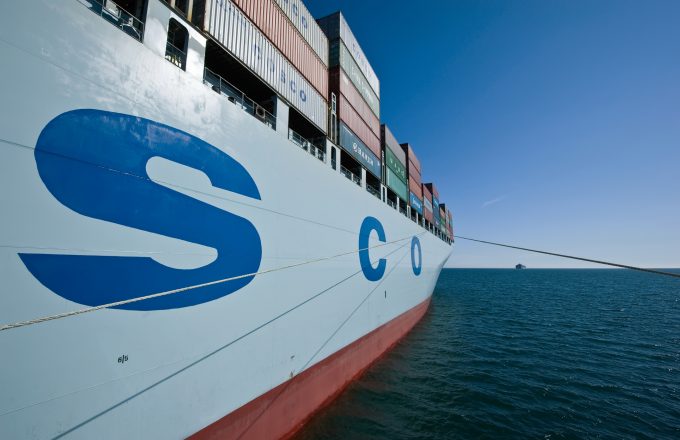Analysis: Felixstowe, London Gateway, MSC & Gemini – musical chairs in UK ports
MSC’s beady eye on Felixstowe?
BA: WIND OF CHANGEMAERSK: BULLISH CALLXPO: HEDGE FUNDS ENGINEF: CHOPPING BOARDWTC: NEW RECORDZIM: BALANCE SHEET IN CHECKZIM: SURGING TGT: INVENTORY WATCHTGT: BIG EARNINGS MISSWMT: GENERAL MERCHANDISEWMT: AUTOMATIONWMT: MARGINS AND INVENTORYWMT: ECOMM LOSSESWMT: ECOMM BOOMWMT: RESILIENCEWMT: INVENTORY WATCH
BA: WIND OF CHANGEMAERSK: BULLISH CALLXPO: HEDGE FUNDS ENGINEF: CHOPPING BOARDWTC: NEW RECORDZIM: BALANCE SHEET IN CHECKZIM: SURGING TGT: INVENTORY WATCHTGT: BIG EARNINGS MISSWMT: GENERAL MERCHANDISEWMT: AUTOMATIONWMT: MARGINS AND INVENTORYWMT: ECOMM LOSSESWMT: ECOMM BOOMWMT: RESILIENCEWMT: INVENTORY WATCH

Cosco Shipping Holdings has posted a net profit of Rmb687m ($102m) for the first three months of the year.
This follows the Chinese state-owned container liner and terminal group’s $251m positive return last year, which, said Alphaliner, included $230m of subsidies from the Chinese government.
Cosco, which acquired OOCL in a $6.3bn deal last July, is the first major container line to report Q1 earnings, and its results suggest it could have been a positive quarter for the industry.
Maersk, the world’s biggest container line, will publish its Q1 results on 24 May.
Thanks mainly to the incorporation of the OOCL container business, the Shanghai and Hong Kong-listed group’s revenue soared 60% year-on-year to Rmb35.1bn.
However, as explained on Loadstar Premium today, the company has adopted new accounting standards and its balance sheet doesn’t look comparable to any others in the industry – according to head of Premium, Alessandro Pasetti, “its first-quarter numbers mean nothing – or very close to nothing”.
Cosco’s liftings reached 5.89m teu, representing an increase of 43%, the biggest jump coming in the intra-Asia and Australasia region, up 71% to 1.84m teu. On Asia-Europe, liftings were up 56% to 1.14m teu and the transpacific route was ahead by 52% to 1.1m teu.
Breaking the numbers down between Cosco and OOCL, the former handled 4.28m teu while Hong Kong-based OOCL saw its volume increase by a modest 1.6% to 1.61m teu.
However, in a separately released operational report OOCL said turnover increased 5.9%, with average revenue per teu up by 4.2% on the same period of 2018. And in its quarterly earnings report, Cosco was keen to stress that it would continue with its strategy of promoting OOCL as a separate brand.
It added that it would “put more efforts on the end-to-end product development and continues to promote the construction of sea-rail intermodal network to further enhance the capacity of the end-to-end logistics solution”.
As at the end of March, Cosco’s combined fleet stood at 478 ships, with a total capacity of 2.77m teu, ranking it third in the ocean carrier league table behind Maersk Line and MSC, and just ahead of Ocean Alliance partner CMA CGM.
Cosco will receive a further nine ULCVs, 19,200-21,200 teu, by the end of June and, with new ULCVs being delivered to Evergreen, it has prompted the Ocean Alliance to launch an extra seventh Asia-North Europe loop this month.
However, soft demand following Chinese new year and a 36% slump in spot rates since January has obliged CMA CGM, Cosco and Evergreen to blank four headhaul sailings early next month.
The impact of these void sailings and the cancelling of three voyages by THE Alliance appears to have succeeded in stabilising the rates on the Asia-North Europe tradelane, supporting 1 May FAK increases, according to Friday’s Shanghai Containerized Freight Index (SCFI).
The Asia-North Europe component of the SCFI put on 12.4% to $717 per teu, reversing the losses of the previous three weeks, and one carrier source told The Loadstar last week his sales team had made “some progress” with its FAK increase.
“Hopefully we are over the worst,” he said, “and now all we need is a strong peak season to cement the gains.”
Comment on this article